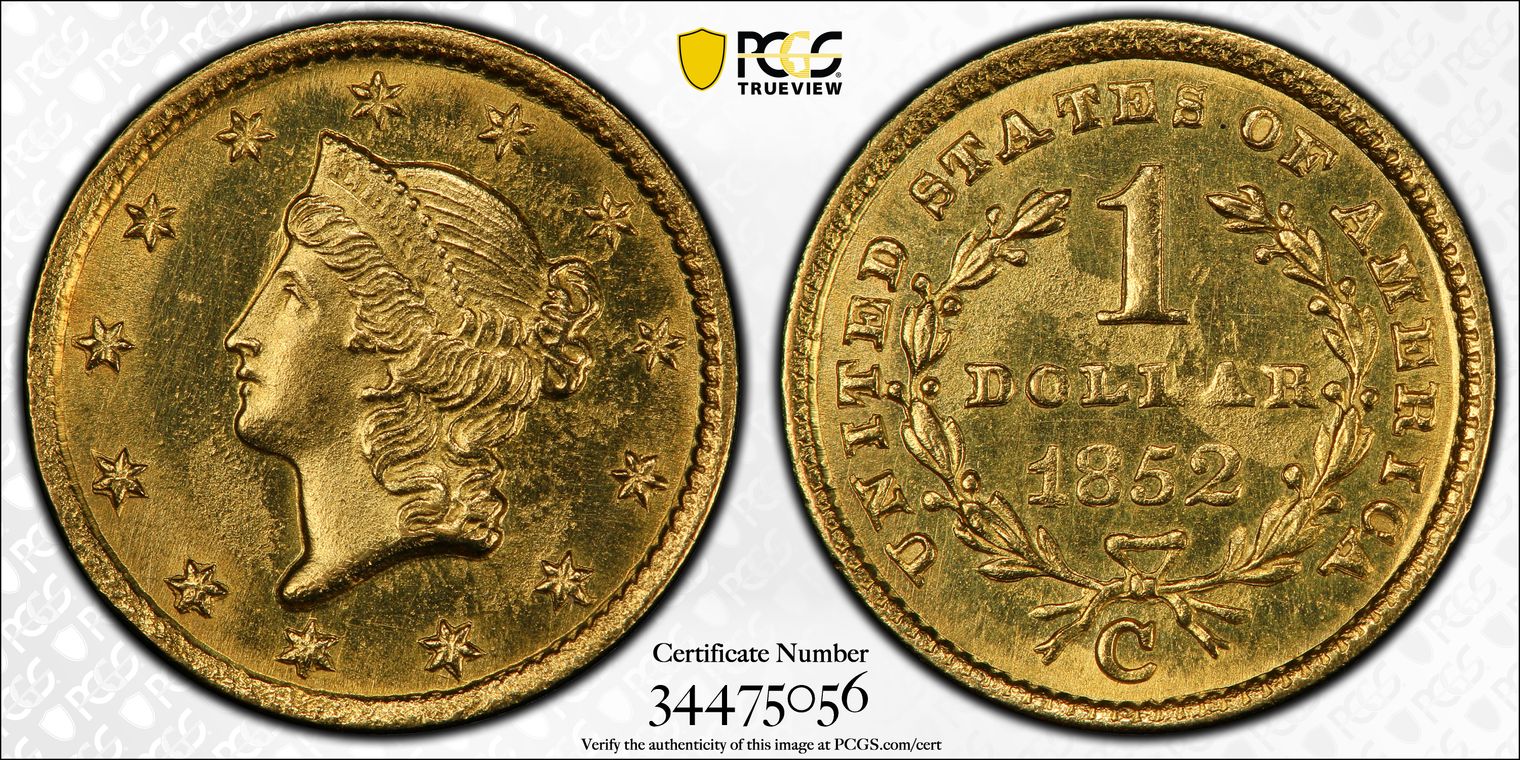1852-C G$1 MS63 认证号34475056, PCGS号7518
专家评论
David Akers (1975/88)
Obviously a very scarce coin from the standpoint of total number of pieces available, but for some unexplained reason, more available in high grade than many other more common dates. A number of specimens that I have seen show an imperfection on the reverse at LA in the DOLLAR which was probably the result of some foreign material adhering to the reverse die. This is not an impairment and in no way affects the value of the coin.Doug Winter
The 1852-C gold Dollar is not as scarce a coin as its low mintage figure would suggest, particularly in higher grades. Although there is no evidence to support this, it is my belief that a hoard of 1852-C gold Dollars existed at one time.The 1852-C gold dollar is usually seen in Very Fine and Extremely Fine grades. It is scarce in the higher About Uncirculated grades although not as much as one might think from a coin with an original mintage of less than 10,000. It is scarce in Uncirculated, but there are more examples known in MS63 and MS64 grades than any other Charlotte gold dollar except for the common 1851-C. There are five or so Gems known as well as one superb MS66.
STRIKE: The 1852-C tends to show an irregular and below average quality of strike. Liberty’s hair is the area that tends to be the most erratically struck. The top of the head is often bold while the hair bun is weak. The hair near the face is weak and the curls below the ear are sometimes almost totally indistinct. The rim is often seen with flatness from 4:00 to 10:00 and the denticles in this area are blurry. The stars from 3:00 to 7:00 are weaker that the rest of the stars. On the reverse, the high spots of the wreath are nearly always flat enough that the beginning collector may confuse this with wear. The letters in DOLLAR are often flat and the date may show weakness on the top of the 8, all of the 5 and the middle of the 2. The denticles are usually blurry and are weaker at the bottom than at the top.
SURFACES: On most pieces, the surfaces show extensive detracting marks and scratches. The 1852-C is a surprisingly difficult coin to locate with clean fields.
LUSTER: There are some higher grade examples known with an exceptionally attractive frosty luster that is grainy in texture. Others exist which are semi-prooflike or even fully prooflike and these are quite rare. The typical example has above-average luster.
COLORATION: Original, uncleaned examples have rich colors which range in hue from an intense orange-gold to a deep green-gold. Coins with attractive natural color are still sometimes available but they are becoming harder to locate as more and more are dipped or brightened.
EYE APPEAL: The eye appeal of many 1852-C gold Dollars is severely compromised by the mint-made planchet imperfection described below. It is still possible to find a nice quality piece that lacks the die imperfection, but these are getting harder to locate every year.
DIE CHARACTERISTICS: Around 50% of all the known examples have weakness and roughness on the reverse that begins at the right side of the 1 and extends down to the right side of the second L and the left side of the A in DOLLAR. This was caused by some foreign matter adhering to the die at the time of striking. This does not tend to affect the grade or value of 1852-C gold dollars, although some collectors prefer to acquire an example that lacks the impairment. Many also show die rust at the reverse border and scattered about the center of the reverse.
DIE VARIETIES: There are two die varieties known.
Variety 1 (formerly Variety 7-G): The 1 in the date is perfect with no signs of repunching. The mintmark is large and positioned slightly to the left. It appears that perfect die coins (those which lack the mint-made imperfection described above) are always this reverse.
Variety 2 (formerly Variety 7-H): The base of an extra 1 can be seen below the center of the base of the 1 in the date. The mintmark is the same size and position as on the other variety. Die rust is often seen, particularly at the reverse border. It appears that the coins which show the mint-made defect described above use this reverse.
This variety is common.
PCGS #
7518
设计师
James Barton Longacre
边缘
Reeded
直径
12.70 毫米
重量
1.70 克
铸币数量
9434
金属成分
90% Gold, 10% Copper
更高评级数量
11
评级较低的钱币数量
111
地区
The United States of America
价格指南
PCGS 数量报告
拍卖 - PCGS 评级的
拍卖 - NGC 评级的
稀有性和存量估计 了解更多
| 所有评级 | 150 |
| 60或以上 | 20 |
| 65或以上 | 3 |
| 所有评级 | R-7.5 |
| 60或以上 | R-9.1 |
| 65或以上 | R-9.8 |
| 所有评级 | 7 / 26 TIE |
| 60或以上 | 10 / 26 TIE |
| 65或以上 | 2 / 26 TIE |
| 所有评级 | 20 / 81 TIE |
| 60或以上 | 22 / 81 TIE |
| 65或以上 | 6 / 81 TIE |






















